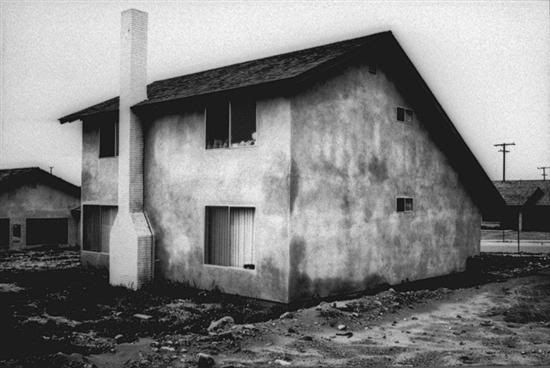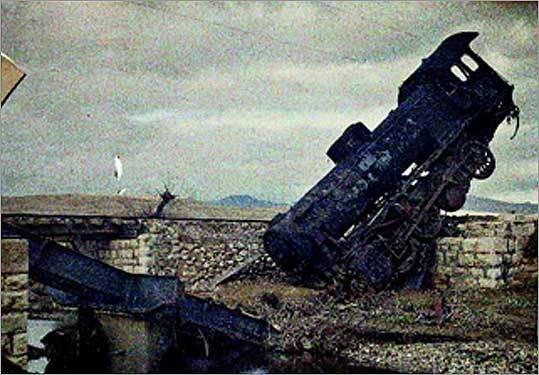 (Doug Rickard)
(Doug Rickard)After a stint browsing the internet today I was starting to despair that as far as good photography is concerned, there is little to be found other than pictures of well dressed urban young women sat in office chairs/perched on the edge of an unmade bed/leaning against a window with a blurred green tree visible beyond it and all looking suitably bored (well, wouldn't you?). Or surveys of well lit and mildly colourful office corridors and their detritus - coffee cups, paper clips, fire buckets, fake potted plants. Or else "A Further Two Hundred Gas Stations of the Mid-West" (soon to be followed by "101 Disused Gas Station of Idaho") - gas stations are to art photography as lone disused barns are to readers of Popular Photography. Or softly lit, gently hued large format deadpan photographs of dwellers of the German suburbs. And as for finding intelligent writing or incisive focused thinking about photography I'd better get back to the library stacks.
And then I came across AMERICANSUBURB X by Doug Rickard - what a great site. Certainly it focuses in the broadest of ways on photography that is in some way to do with the suburban (and urban) condition - although considering that that's over 50% of the population (and over 80% if you add the urban population) of N. America I think there's plenty of room to manoeuvre.
AMERICANSUBURBX essentially seems to be a compendium of some of the best writing about (along with a lot of the best photography about) our suburban world here. Which in effect means that's some of the best writing and photogrpahy of the last 20+ years or so (in fact it delves much further into the past than 20 years, drawing on some of the roots that have fed so much of the good photography today). There are magazine and newspaper articles, essays - some independent, some drawn from particular books and monographs. There are also some very current articles and interviews. There are videos and goodness knows what else tucked away in it. If you wanted to get a feel for and understanding of this central aspect of contemporary photography you could do worse than ready through everything on this site.
Just a few examples and extracts (there are long lists if you go to the drop-down menus):
There's an interview with Walker Evans:
PAUL CUMMINGS: Let’s see, you started becoming interested in photography again after about 1928?
WALKER EVANS: Yes.
PAUL CUMMINGS: What kind of things did you photograph? What were you interested in doing with the camera at that point?
WALKER EVANS: I think I was photographing against the style of the time, against salon photography, against beauty photography, against art
photography.
PAUL CUMMINGS: The whole elaborate business –
WALKER EVANS: Yes. Even including Stieglitz. I was doing non-artistic and non- commercial work. I felt – and it’s true – I was on the right track. I sensed that I was turning new ground. At least I though I was mining a new vein, sort of instinctively knowing it but not in any other way aware of it....

There's John Szarkowski's introduction to William Eggleston's Guide
"...One can say, to repeat, that in Eggleston's pictures form and content are indistinguishable, which seems to me true but also unsatisfactory because too permissive. The same thing can be said of any picture. The ambitious photographer, not satisfied by so tautological a success, seeks those pictures that have a visceral relation to his own self and his own privileged knowledge, those that belong to him by genetic right, in which form matches not only content but intent.
This suggests that the pictures reproduced here are no more interesting than the person who made them, and that their intelligence, wit, knowledge, and style reach no farther than that person's - which leads us away from the measurable relationships of art-historical science toward intuition, superstition, blood-knowledge, terror, and delight.
These pictures are fascinating partly because they contradict our expectations. We have been told so often of the bland, synthetic smoothness of exemplary American life, of its comfortable, vacant insentience, its extruded, stamped, and molded sameness, in a word its irredeemable dullness, that we have come half to believe it, and thus are startled and perhaps exhilarated to see these pictures of prototypically normal types on their familiar ground, grandchildren of Penrod, who seem to live surrounded by spirits, not all of them benign. The suggestible viewer might sense that these are subjects capable not only of the familiar modern vices (self-loathing, adaptability, dissembling, sanctimony, and license), but of the ancient ones (pride, parochial stubbornness, irrationality, selfishness, and lust). This could not be called progress, but it is interesting. Such speculations, however, even if not simple nonsense, presumably relate only toEggleston's pictures - patterns of random facts in the service of one imagination - not to the real world. A picture is after all only a picture, a concrete kind of fiction, not to be admitted as hard evidence or as the quantifiable data of social scientists.
As pictures, however, these seem to me perfect: irreducible surrogates for the experience they pretend to record, visual analogues for the quality of one life, collectively a paradigm of a private view, a view one would have thought ineffable, described here with clarity, fullness, and elegance.".

(William Eggleston)
There's an interview; "Lewis Baltz, Subjects and Objects of the New Technological Culture"
Q.
But in some ways digital technologies change the relationship between the real and the virtual, because we have a real virtual world now. We have virtual reality in which we can have another world different from the real one...
A.
I think the balance is tipping in favour of the virtual and away from the real. But as I said before, I think that that balance had already started to tip before digital technologies. Their presence now accelerates that. Not only the presence of the technologies but the availability of the technologies. Everyone now can work with some sort of digital procedure. People are on the Internet, people work with digital cameras. Almost everything now has that possibility, maybe even the necessity, of some kind of digital interface or intervention. So in that sense, the sense that it proliferates, that it's everywhere in society, I think that will yet further detach people from whatever 19th century idea they had about reality, the phenomenal world and their relation to it and in it. Whether that change is an improvement or we are entering a dangerous brave new world, it's really impossible to say. In any case, it is the reality, it's the world we are entering, it's the world we're already half into.

(Lewis Baltz)
There's an interview with Gary Winogrand
D: What do you look for?
W: I look at a photograph. What's going on? What's happening, photographically? If it's interesting, I try to understand why.
D: And how do you expect the viewer to respond to your photographs?
W: I have no expectations. None at all.
D: Well, what do you want to evoke?
W: I have no ideas on that subject. Two people could look at the same flowers and feel differently about them. Why not? I'm not making ads. I couldn't care less. Everybody's entitled to their own experience...

There's Todd Hido's upcoming "Two Way Street"
"...In the context of this horribly mundane world of current contemporary photography, Todd's work stands apart from the pack by a wide gap. This gap is made up by the sledgehammer authenticity of Todd's vision, by a violent undercurrent of emotion that hits the viewer like a baseball bat clearing a drunken human path. I don't care about the reality, only the photographs matter and what they exist as - what they say - what they are - not what Todd is.
This is photography... as it should be. Giving a middle finger to genre, telling concept or categorization to kindly f-off, Todd has upped his ante with the new work and continues to be left to stand in his own space, defying classification... carving out his own path.
As it should be...."

(Todd Hido)
There's Taryn Simon's An American Index of the Hidden and the Unfamiliar (3 Steps to the Taryn Simon Experience)
"Step 1.
First look at Taryn Simon's photographs without any context, without any frame of reference and certainly without any text. To do this is to enter a fantastically bizarre world, a circus like freak show of sites, human things, animals and locations... a whizzing siren of color. Empty-yet-clear, distorted-yet-shaped scenes abound, alien-American-laboratory textures, sounds and surfaces. Without context the photographs are joyfully disturbing and fascinatingly covert... almost like entering secretly into a spy story as an invisible spectator only the spies are spying on you and the story is taking place with you at the center. Pardoxically, the images are disparate and unconnected but also connected and to a certain extent, cohesive. Like the work of Michele Abeles assorted puzzle pieces are there on the table, the fabric patchwork of "the quilt" seems to be stitched together. A story is asking you if it can be "told"... but the secret story is encrypted... the "code" is planted under the surface... everything is connected but somewhere down at the root..."

(Taryn Simon - CIA Headquaters from Taryn Simon's An American Index of the Hidden and the Unfamiliar )
And there is The Twighlight of Color Photography by By Dushko Petrovich from the Boston Globe
"...But as with each of our advances, something else is being lost. It is easy to think of the print and the digital image as the same thing, but they're actually very different. Even as cameras tout their ever-increasing megapixels, nearly everything we view is projected out at 72 dots per inch, the standard resolution of a monitor. The resulting pictures are back-lit, vivid, and very easy to scan, so we hardly notice how hard it is to look into them. Your eyes move side to side, and you can easily gather all the information, but if you linger for a minute - an actual minute - you'll notice that the screen doesn't quite accept your gaze. A printed photograph, however - even when small, or blurry - has a way of letting you in. The paper surface is less aggressive than the liquid crystal one, so your eyes can roam around. The brightness of the pixel has a price: The illusory space of the photo is subtly reduced, along with its invitation to wander - or simply rest - inside it.
Of course, the real space photographs take up is also reduced. Like most technology, the color print seemed ever so sleek . . . until we saw the upgrade. A laptop effortlessly holds what hundreds of shoe boxes could not; we now send 50 pictures with a click. Still, the actual third dimension is an important aspect of the supposedly 2D print; the physical contact establishes a certain intimacy. Who has not held a photograph and wept? Who hasn't felt their nostalgia settle for an instant on the thinness of a print? To hold a photo is to hold a person, or even a place, in your hand - a momentary illusion that has no parallel on a monitor...
...But just as the paperless format erases one kind of closeness, it can open entirely new realms of intimacy - the minute you hit "upload." While our stored photos are shy (you have to search for them) and a little vulnerable (they can all disappear with a hard drive), the ones we put on the Web are gregarious and immortal. Never before has the photo been so emphatically public, announcing our achievements and pleasures with a swiftness we never dreamed of. So even when these disseminated images come to haunt us, it's not in the manner of the print - which conjured private sentiments, like longing or regret - but with rather more civic feelings, like shame and embarrassment. Usually these unnerving photos are the ones other people have posted (and "tagged"), but what's really irksome is that other people are seeing them, and that these other people can even copy them and distribute them, if they so choose. The old idea of "destroy the negatives" sounds pretty quaint in a world of endlessly reproducible jpegs, as does the notion of asking to take someone's picture. We're all celebrities now! But it is the photographs, not their subjects, that are godlike in their movements...."

(A train upended by Westward-fleeing Greeks in 1923 in Turkey. Musee Albert Kahn)
and much much more...






2 comments:
Tim, I loved that opening paragraph, have had similar thoughts along these lines, including about the girl in the office chair.
Great site, thanks for finding it.
--- Luis
I agree with luis... GREAT find! I love the concept of the website and the content of the photographs. I have always been one to enjoy taking photographs near home, not necessarily of the community, but of nature in the community, which I guess somewhat makes up the community. The concept that you don't have to go very far to get a photograph intrigues me, and most of the time the best photographs lay right outside your front door.
Not only is the concept strong but also most of the photographs are visually intriguing. With almost every single photograph there is an element familiar to the eye, a suburban element that most of the US population would recognize. I feel as if it is this element that allows everyone to connect to each and everyone of the photographs. Everybody brings their own meaning with them when viewing the photos.
As far as the artist views, I find myself similar to Gary Winogrand who states that he has no expectations as to what he wants the viewer to see and that he has no ideas on what he wants to evoke from the viewer. I am the same way. I take pictures because something looks nice or interesting, not because I think how meaningful it can be or because I want the audience to react in a certain way.
Post a Comment